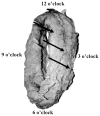Structure-function relationship of the human external anal sphincter
- PMID: 28689239
- PMCID: PMC5889349
- DOI: 10.1007/s00192-017-3404-6
Structure-function relationship of the human external anal sphincter
Abstract
Introduction and hypothesis: Obstetrical external anal sphincter (EAS) injury and subsequent dysfunction are leading risk factors for female fecal incontinence (FI). Limited knowledge of the EAS structure-function relationship hinders treatment optimization. We directly measured functionally relevant intrinsic parameters of human EAS and tested whether vaginal delivery alters the EAS structure-function relationship.
Methods: Major predictors of in vivo EAS function were compared between specimens procured from vaginally nulliparous (VN, n = 5) and vaginally parous (VP, n = 7) cadaveric donors: operational sarcomere length (Ls), which dictates force-length relationship; physiological cross-sectional area (PCSA), which determines isometric force-generating capacity; fiber length (Lfn), responsible for muscle excursion and contractile velocity; and muscle stiffness. Data were analyzed using unpaired and paired t tests, α < 0.05. Results are presented as mean ± SEM.
Results: The VN and VP (median parity 3) groups were similar in age and BMI. No gross anatomical defects were identified. EAS Ls (2.36 ± 0.05 μm) was shorter than the optimal Lso (2.7 μm), at which contractile force is maximal, P = 0.0001. Stiffness was lower at Ls than Lso (5.4 ± 14 kPa/μm vs 35.3 ± 12 kPa/μm, P < 0.0001). This structural design allows active and passive tension to increase with EAS stretching. EAS relatively long Lfn (106 ± 24.8 mm) permits rapid contraction without decreased force, whereas intermediate PCSA (1.3 ± 0.3 cm2) is conducive to maintaining resting tone. All parameters were similar between groups.
Conclusions: This first direct examination of human EAS underscores how EAS intrinsic design matches its intended function. Knowledge of the EAS structure-function relationship is important for understanding the pathogenesis of FI and the optimization of treatments for EAS dysfunction.
Keywords: External anal sphincter; Fecal incontinence; Muscle architecture.
Figures



Similar articles
-
The external anal sphincter operates at short sarcomere length in humans.Neurogastroenterol Motil. 2011 Jul;23(7):643-e258. doi: 10.1111/j.1365-2982.2011.01700.x. Epub 2011 Mar 21. Neurogastroenterol Motil. 2011. PMID: 21418426
-
Novel applications of external anal sphincter muscle sarcomere length to enhance the anal canal function.Neurogastroenterol Motil. 2011 Jan;23(1):70-5, e7. doi: 10.1111/j.1365-2982.2010.01608.x. Epub 2010 Oct 12. Neurogastroenterol Motil. 2011. PMID: 20939857
-
Length-tension relationship of the external anal sphincter muscle: implications for the anal canal function.Am J Physiol Gastrointest Liver Physiol. 2008 Aug;295(2):G367-73. doi: 10.1152/ajpgi.00033.2008. Epub 2008 Jul 3. Am J Physiol Gastrointest Liver Physiol. 2008. PMID: 18599590 Free PMC article.
-
The external anal sphincter and the role of surface electromyography.Neurogastroenterol Motil. 2005 Jun;17 Suppl 1:60-7. doi: 10.1111/j.1365-2982.2005.00660.x. Neurogastroenterol Motil. 2005. PMID: 15836456 Review.
-
Pathophysiology of adult fecal incontinence.Gastroenterology. 2004 Jan;126(1 Suppl 1):S14-22. doi: 10.1053/j.gastro.2003.10.013. Gastroenterology. 2004. PMID: 14978634 Review.
Cited by
-
Oscillating calcium signals in smooth muscle cells underlie the persistent basal tone of internal anal sphincter.J Cell Physiol. 2021 Aug;236(8):5937-5952. doi: 10.1002/jcp.30279. Epub 2021 Jan 16. J Cell Physiol. 2021. PMID: 33452672 Free PMC article.
-
Bladder and urethral dysfunction in multiparous and mature rabbits correlates with abnormal activity of pubococcygeus and bulbospongiosus muscles.Neurourol Urodyn. 2020 Jan;39(1):116-124. doi: 10.1002/nau.24176. Epub 2019 Oct 2. Neurourol Urodyn. 2020. PMID: 31578766 Free PMC article.
-
Mechanical impact of parturition-related strains on rat pelvic striated sphincters.Neurourol Urodyn. 2019 Mar;38(3):912-919. doi: 10.1002/nau.23946. Epub 2019 Feb 19. Neurourol Urodyn. 2019. PMID: 30779377 Free PMC article.
-
Impact of sex and aging on radiographic and functional parameters of the anal sphincter complex in patients with accidental bowel leakage.Neurourol Urodyn. 2023 Apr;42(4):751-760. doi: 10.1002/nau.25151. Epub 2023 Feb 19. Neurourol Urodyn. 2023. PMID: 36805621 Free PMC article.
References
-
- Bharucha AE, Dunivan G, Goode PS, Lukacz ES, Markland AD, Matthews CA, et al. Epidemiology, pathophysiology, and classification of fecal incontinence: state of the science summary for the National Institute of Diabetes and Digestive and Kidney Diseases (NIDDK) workshop. Am J Gastroenterol. 2015;110(1):127–36. - PMC - PubMed
-
- Dudding TC, Vaizey CJ, Kamm MA. Obstetric anal sphincter injury: incidence, risk factors, and management. Ann Surg. 2008;247(2):224–37. - PubMed
-
- American College of Obstetricians and Gynecologists’ Committee on Practice Bulletins—Obstetrics. Cichowski S, Rogers R. Practice bulletin no. 165: prevention and management of obstetric lacerations at vaginal delivery. Obstet Gynecol. 2016;128(1):e1–e15. - PubMed
MeSH terms
Grants and funding
LinkOut - more resources
Full Text Sources
Other Literature Sources
Miscellaneous

